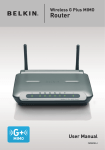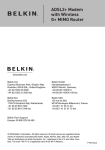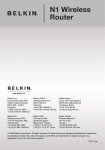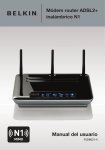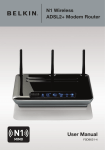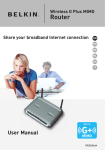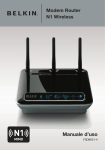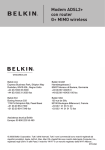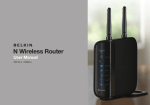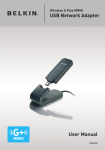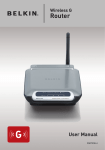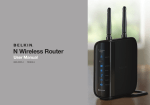Download User Manual
Transcript
Wireless G+ MIMO ADSL2+ Modem Router ������� ���� User Manual F5D9630-4 Table of Contents 1 Introduction ............................................................................................. 1 Advantages of a Wireless Network ................................................................. 1 Placement of your Wireless G Plus MIMO ADSL2+ Modem Router .........2 2 Product Overview ..................................................................................... 5 Product Features ........................................................................................... 5 3 Knowing your Router ................................................................................ 7 Package Contents .......................................................................................... 7 System Requirements .................................................................................... 7 Setup Assistant Software System Requirements .......................................... 7 The Network Status Display ............................................................................ 8 4 Connecting and Configuring your Router ............................................... 12 5 Alternate Setup Method ......................................................................... 22 6 Using the Web-Based Advanced User Interface ..................................... 33 Changing LAN Settings ................................................................................ 34 Viewing the DHCP Client List Page ............................................................. 35 Configuring the Wireless Network Settings ................................................. 36 Setting WPA Security .................................................................................... 41 Setting WEP Encryption ............................................................................... 43 7 Manually Configuring Network Settings ................................................ 62 8 Recommended Web Browser Settings ................................................... 67 9 Troublshooting ...................................................................................... 70 10 Information .......................................................................................... 83 Introduction • Share one high-speed Internet connection with all the computers in your home • Share resources, such as files and hard drives among all the connected computers in your home • Share a single printer with the entire family • Share documents, music, video, and digital pictures • Store, retrieve, and copy files from one computer to another • Simultaneously play games online, check Internet email, and chat Advantages of a Wireless Network Here are some of the advantages of setting up a Belkin Wireless Network: • Mobility – you’ll no longer need a dedicated “computer room”— now you can work on a networked laptop or desktop computer anywhere within your wireless range • Easy installation – Belkin’s Easy Installation Wizard makes setup simple • Flexibility – set up and access printers, computers, and other networking devices from anywhere in your home • Easy Expansion – the wide range of Belkin networking products let you expand your network to include devices such as printers and gaming consoles • No cabling required – you can spare the expense and hassle of retrofitting Ethernet cabling throughout the home or office • Widespread industry acceptance – choose from a wide range of interoperable networking products. 1 1 2 3 4 5 6 7 8 9 10 12 section Thank you for purchasing the Belkin ADSL Modem with High-Speed Mode Wireless G Router (the Router). In minutes you will be able to share your Internet connection and network your computers with your new Router. The following is a list of features that make your Router an ideal solution for your home or small office network. Please be sure to read through this User Manual completely, and pay special attention to Appendix B entitled “Important Factors for Placement and Setup”. Introduction Placement of your Wireless G Plus MIMO ADSL2+ Modem Router Important Factors for Placement and Setup Your wireless connection will be stronger the closer your computer is to your Router. Typical indoor operating range for wireless devices is between 100 and 200 feet. In the same way, your wireless connection and performance will degrade somewhat as the distance between your Router and connected devices increases. This may or may not be noticeable to you. As you move further from your Router, connection speed may decrease. Factors that can weaken signals simply by getting in the way of your network’s radio waves are metal appliances or obstructions, and walls. If you have concerns about your network’s performance that might be related to range or obstruction factors, try moving the computer to a position between five and 10 feet from the Router in order to see if distance is the problem. If difficulties persist even at close range, please contact Belkin Technical Support. Note: While some of the items listed below can affect network performance, they will not prohibit your wireless network from functioning; if you are concerned that your network is not operating at its maximum effectiveness, this checklist may help. 1. Router Placement Place your Router, the central connection point of your network, as close as possible to the center of your wireless network devices. To achieve the best wireless network coverage for your “wireless clients” (i.e., computers enabled by Belkin Wireless Notebook Network Cards, Wireless Desktop Network Cards, and Wireless USB Adapters): • Ensure that your Router’s networking antennas are parallel to each other, and are positioned vertically (toward the ceiling). If your Router itself is positioned vertically, point the antennas as much as possible in an upward direction. • In multistory homes, place the Router on a floor that is as close to the center of the home as possible. This may mean placing the Router on an upper floor. • Try not to place the Router near a cordless 2.4GHz phone. The Router is designed to be placed on a desktop. All of the cables exit from the rear of the Router for better organization and utility. The LED indicators are easily visible on the front of the Router to provide you with information about network activity and status. 2 Introduction Avoid placing your Router near devices that may emit radio “noise,” such as microwave ovens. Dense objects that can inhibit wireless communication include: • Refrigerators • Washers and/or dryers • Metal cabinets • Large aquariums • Metallic-based UV tinted windows If your wireless signal seems weak in some spots, make sure that objects such as these are not blocking the signal’s path (between your computers and Router). 2 3 4 5 3. Cordless Phones 6 If the performance of your wireless network is impaired after attending to the above issues, and you have a cordless phone: 7 • • • • Try moving cordless phones away from your Router and your wireless-enabled computers. Unplug and remove the battery from any cordless phone that operates on the 2.4GHz band (check manufacturer’s information). If this fixes the problem, your phone may be interfering. If your phone supports channel selection, change the channel on the phone to the farthest channel from your wireless network. For example, change the phone to channel 1 and move your Router to channel 11. See your phone’s user manual for detailed instructions. If necessary, consider switching to a 900MHz or 5GHz cordless phone. 4. Choose the “Quietest” Channel for your Wireless Network In locations where homes or offices are close together, such as apartment buildings or office complexes, there may be wireless networks nearby that can conflict with yours. Use the Site Survey capabilities found in the Wireless Utility of your wireless adapter to locate any other wireless networks that are available (see your wireless adapter’s user manual), and move your Router and computers to a channel as far away from other networks as possible. • Experiment with more than one of the available channels, in order to find the clearest connection and avoid interference from neighboring cordless phones or other wireless devices. • For Belkin wireless networking products, use the detailed Site Survey and wireless channel information included with your wireless network card. See your network card’s user guide for more information. 3 8 9 10 12 section 1 2. Avoid Obstacles and Interference Introduction These guidelines should allow you to cover the maximum possible area with your Router. Should you need to cover an even wider area, we suggest the Belkin Wireless Range Extender/Access Point. 5. Secure Connections, VPNs, and AOL Secure connections typically require a user name and password, and are used where security is important. Secure connections include: • Virtual Private Network (VPN) connections, often used to connect remotely to an office network • The “Bring Your Own Access” program from America Online (AOL), which lets you use AOL through broadband provided by another cable or DSL service • Most online banking websites • Many commercial websites that require a user name and password to access your account Secure connections can be interrupted by a computer’s power management setting, which causes it to “go to sleep.” The simplest solution to avoid this is to simply reconnect by rerunning the VPN or AOL software, or by re-logging into the secure website. A second alternative is to change your computer’s power management settings so it does not go to sleep; however, this may not be appropriate for portable computers. To change your power management setting under Windows, see the “Power Options” item in the Control Panel. If you continue to have difficulty with Secure Connections, VPNs, and AOL, please review the steps above to be sure you have addressed these issues. For more information regarding our networking products, visit our website at www.belkin.com/networking or call Belkin Technical Support at: USA: 877-736-5771 UK: 0845 607 77 87 Australia: 1800 235 546 New Zealand: 0800 235 546 Singapore: 800 616 1790 310-898-1100 ext. 2263 Europe: www.belkin.com/support 4 Product Overview 1 Product Features In minutes you will be able to share your Internet connection and network your computers. The following is a list of features that make your new Belkin Wireless G Plus MIMO ADSL2+ Modem Router an ideal solution for your home or small office network. Works with Both PCs and Mac® Computers The Router supports a variety of networking environments including Mac OS® 8.x, 9.x, X v10.x, Linux ®, Windows ® 98, Me, NT ®, 2000, XP, and Vista™, and others. All that is needed is an Internet browser and a network adapter that supports TCP/IP (the standard language of the Internet. Web-Based Advanced User Interface You can set up the Router’s advanced functions easily through your web browser, without having to install additional software onto the computer. There are no disks to install or keep track of and, best of all, you can make changes and perform setup functions from any computer on the network quickly and easily. NAT IP Address Sharing Your Router employs Network Address Translation (NAT) to share the single IP address assigned to you by your Internet Service Provider while saving the cost of adding IP addresses to your Internet service account. 2 3 4 5 6 7 8 9 10 12 SPI Firewall Your Router is equipped with a firewall that will protect your network from a wide array of common hacker attacks including IP Spoofing, Land Attack, Ping of Death (PoD), Denial of Service (DoS), IP with zero length, Smurf Attack, TCP Null Scan, SYN flood, UDP flooding, Tear Drop Attack, ICMP defect, RIP defect, and fragment flooding. Integrated 10/100 4-Port Switch The Router has a built-in, four-port network switch to allow your wired computers to share printers, data and MP3 files, digital photos, and much more. The switch features automatic detection so it will adjust to the speed of connected devices. The switch will transfer data between computers and the Internet simultaneously without interrupting or consuming resources. 5 section Product Features Product Overview Universal Plug and Play (UPnP) UPnP is a technology that offers seamless operation of voice messaging, video messaging, games, and other applications that are UPnP-compliant. Support for VPN Pass-Through If you connect to your office network from home using a VPN connection, your Router will allow your VPN-equipped computer to pass through the Router and to your office network. Built-In Dynamic Host Configuration Protocol (DHCP) Built-In Dynamic Host Configuration Protocol (DHCP) on-board makes for the easiest possible connection of a network. The DHCP server will assign IP addresses to each computer automatically so there is no need for a complicated networking setup. Setup Assistant The Setup Assistant, second generation of Belkin’s renowned Easy Install Wizard, takes the guesswork out of setting up your Router. This automatic software determines your network settings for you and sets up the Router for connection to your Internet Service Provider (ISP). In a matter of minutes, your Router will be up and running on the Internet. Note: Setup Assistant software is compatible with Windows 2000 and XP. If you are using another operating system, the Router can be set up using the Alternate Setup Method described in this User Manual (see page 22). Integrated Wireless G Plus MIMO Access Point Wireless G Plus MIMO is an exciting new wireless technology. It employs MIMO (Multiple Input Multiple Output) smart-antenna technology that achieves data rates above the standard 802.11g throughput. Actual throughput is typically lower than the connected data rate and will vary depending on your networking environment. MAC-Address Filtering For added security, you can set up a list of MAC addresses (unique client identifiers) that are allowed access to your network. Every computer has its own MAC address. Simply enter these MAC addresses into a list using the Web-Based Advanced User Interface and you can control access to your network. 6 Knowing your Router 1 Package Contents Belkin Wireless G Plus MIMO ADSL2+ Modem Router • Quick Installation Guide • Belkin Setup Assistant Software CD • RJ11 Telephone Cord • RJ45 Ethernet Networking Cable • ADSL (Asymmetric Digital Subscriber Line) Microfilter* • Power Supply • User Manual in CD 2 3 4 5 6 *ADSL microfilter varies by country. If it’s not included, you will need to purchase one. System Requirements • An active ADSL service with a telephone wall jack for connecting the Router • At least one computer with an installed network interface adapter • TCP/IP networking protocol installed on each computer • No other DHCP server on your local network assigning IP addresses to computers and devices • Internet browser Setup Assistant Software System Requirements • A PC running Windows ® 2000 or XP • Minimum 500MHz processor and 128MB RAM • Internet browser Internet Connection Settings The Setup Assistant contains a database of Internet Service Providers (ISPs) in each country to help you set up your Router quickly. If your ISP is not on the list, please collect the following information from your ISP before setting up the Router: • Internet connection protocol: _________ (PPPoE, PPPoA, Dynamic IP, Static IP) • Multiplexing method or Encapsulation: _________ (LLC or VC MUX) 7 7 8 9 10 12 section • Knowing your Router • Virtual circuit: VPI (Virtual Path Identifier) __________ (a number between 0 and 255) • VCI (Virtual Channel Identifier) __________ (a number between 1 and 65535) • For PPPoE and PPPoA users: ADSL account user name ________ and password _______________ • For static IP users: IP Address ___ . ___ . ___ . ___ Subnet Mask ___ . ___ . ___ . ___ Default Gateway Server ___ . ___ . ___ . • IP address for Domain Name Server ___ . ___ . ___ . ___ (If given by your ISP) The Network Status Display The Router has been designed to be placed on a desktop. All of the cables exit from the rear of the Router for better organization and utility. The Network Status Display is easily visible on the FRONT of the Router to provide you with information about network activity and status. See the Network Status Display Guide for more detailed information. Front Panel (2) (1) (3) (4) (5) 1. Power LED When you apply power to the Router or restart it, a short period of time elapses while the Router boots up. When the Router has completely booted up, the Power LED becomes a GREEN light, indicating the Router is ready for use. OFF Router is OFF Green Router is ON Red Router failed to start 8 Knowing your Router 1 2. LAN Status LEDs Orange Ethernet link is up and 10Base-T device connected Orange - blinking 10Base-T device is transmitting or receiving data Green Ethernet link is up and 100Base-T device is connected Green - blinking 100Base-T device is transmitting or receiving data 2 3 4 5 6 7 8 3. WLAN Status LED The WLAN Status LED is solid GREEN when you enable the wireless LAN function. It flashes when the Router is transmitting or receiving data wirelessly. Green WLAN is up and connected Green - blinking Transmitting or receiving data 9 10 12 4. ADSL LED The ADSL LED flashes GREEN during negotiation with your ISP. It stays GREEN when the Router is connected properly to your ADSL service. OFF No ADSL connection Green - blinking Negotiating connection Green ADSL link is up and connected 9 section These LAN Status LEDs are labeled 1–4 and correspond to the numbered ports on the rear of the Router. When a computer is properly connected to one of the LAN ports on the rear of the Router, the LED will light. Solid GREEN means a computer or a network-enabled device is connected. When information is being sent over the port, the LED blinks rapidly. ORANGE indicates a 10Base-T connection. Knowing your Router 5. Internet LED The Internet LED shows you when the Router is connected to the Internet. When the LED is OFF, the Router is NOT connected to the Internet. When the LED is solid GREEN, the Router is connected to the Internet. When the LED is blinking, the Router is transmitting or receiving data from the Internet. OFF No Internet connection Green Connected to the Internet Green - blinking Transmitting or receiving data Red Failed to connect to the Internet Back Panel (6) (9) (8) (7) 6. DSL Line This port is for connection to your ADSL. Connect your ADSL to this port. 7. Ethernet Ports The Ethernet ports are RJ45, 10/100 auto-negotiation. The ports are labeled 1 through 4. These ports correspond to the numbered LEDs on the front of the Router. Connect your network-enabled computers or any networking devices to one of these ports. 10 Knowing your Router 1 8. Reset Button a. Resetting the Router Push and hold the “Reset” button for one second, then release it. When the “Power/Ready” light becomes solid again, the reset is complete. b. Restoring the Factory Defaults Press and hold the “Reset” button for at least five seconds, then release it. When the “Power/Ready” light becomes solid again, the restore is complete. 9. Power Plug Connect the included DC power supply to this inlet. Using the wrong type of power adapter may cause damage to your Router. 2 3 4 5 6 7 8 9 10 12 11 section The “Reset” button is used in rare cases when the Router may function improperly. Resetting the Router will restore the Router’s normal operation while maintaining the programmed settings. You can also restore the factory default settings by using the “Reset” button. Use the restore option in instances where you may have forgotten your custom password. Connecting and Configuring your Router Verify the contents of your box. You should have the following: • Belkin Wireless G Plus MIMO ADSL2+ Modem Router • RJ11 Telephone Cord • RJ45 Ethernet Networking Cable • Power Supply • Belkin Setup Assistant Software CD • User Manual Setup Assistant Belkin has provided our Setup Assistant software to make installing your Router a simple and easy task. You can use it to get your Router up and running in minutes. The Setup Assistant requires that your Windows 2000 ,XP or Vista computer be connected directly to your ADSL and that the Internet connection is active and working at the time of installation. If it is not, you must use the “Alternate Setup Method” section of this User Manual to configure your Router. Additionally, if you are using an operating system other than Windows 2000,XP, or Mac OS X you must set up the Router using the “Alternate Setup Method” section of this User Manual. Step 1A: Hardware Connections – Follow the Quick Installation Guide (QIG) Brand-New Setup Follow these steps if you are not replacing an existing modem. If you are replacing an existing modem, skip to the next section, “Replacing an Existing Modem or Modem Router”, starting on page 13 1A.1 Unpack your new Router from the box and place it next to your computer. Raise the Router’s antennas. 1A.2 Retrieve the yellow RJ45 cable that was included with your Router. First, connect one end to any yellow port labeled “Wired Computers” on the back of your Router. Then, connect the other end to the networking port on the back of your computer. 1A.3 Retrieve the included gray RJ11 phone cord. Connect one end to the gray port labeled “DSL” on the back of your Router. Then connect the other end to your ADSL connection (either a wall jack or an ADSL splitter). 12 Connecting and Configuring your Router Note: Some ADSL connections require a microfilter. Your ADSL provider can tell you if you need one. Belkin includes a microfilter in regions known to use them. You may or may not have received one in your box. Step 1B: Replacing an Existing Modem or Modem Router Follow these steps if you currently have a modem or a modem router that you will be replacing with your new Router. 1B.1 Unpack your new Router from the box and place it next to your old modem. Raise the Router’s antennas. Unplug your old modem’s power cord. 1B.2 Locate the cable that connects your old modem to your computer. Unplug that cable from your old modem, and plug it into any yellow port labeled “Wired Computers” on the back of your new Router. 1B.3 Locate the cable that connects your old modem to the ADSL wall jack. Unplug it from your old modem and then connect it to the gray port labeled “DSL” on the back of your Router. 2 3 4 5 6 7 8 9 10 1B.4 Plug your Router’s power supply into the black port labeled “Power” on the back of your Router. 1B.5 Wait 30 seconds for the Router to start up. Look at the front panel on the Router. Make sure one of the “LAN” and the “POWER” icons are lit. If they are not, recheck your connections. Step 2: Set Up the Router – Run the Setup Assistant Software 2.1 Shut down any programs that are running on your computer at this time. Turn off any firewall or Internet-connection-sharing software on your computer. 2.2 Insert the CD into your computer. The Setup Assistant will automatically appear on your computer’s screen within 15 seconds. Click on “Go” to run the Setup Assistant. Follow the instructions there. 13 12 section 1A.4 Plug your Router’s power supply into the black port labeled “Power” on the back of your Router . Wait 30 seconds for the Router to start up. Look at the front panel of the Router. Make sure one of the “LAN” and the “POWER” LED’s are both lit up. If they are not, recheck your connections. 1 Connecting and Configuring your Router Note for Windows Users: If the Setup Assistant does not start up automatically, select your CD-ROM drive from “My Computer” and double-click on the file named “SetupAssistant” to start the Setup Assistant. NOTE TO MAC® USERS: Double-click on the “Easy Install” icon to start the Setup Assistant. Then, follow the prompts to complete the setup. 2.3 Select Country. Select your country from the drop-down box. Click “Begin” to continue. 14 Connecting and Configuring your Router 2.4 Confirmation Screen. Verify that you have completed all QIG steps by checking the box to the right of the arrow. Click “Next” to continue. 1 2 3 5 6 7 8 2.5 Progress Screen. Setup Assistant will show you a progress screen each time a step in the setup has been completed. 9 10 12 15 section 4 Connecting and Configuring your Router 2.6 Checking Settings. The Setup Assistant will now examine your computer’s network settings and gather information needed to complete the Router’s connection to the Internet. 2.7 Verifying Hardware Connections. The Setup Assistant will now verify your hardware connection. 16 Connecting and Configuring your Router 2.8 Naming your Wireless Network. The Setup Assistant will display the default wireless network name or Service Set Identifier (SSID). This is the name of your wireless network to which your computers or devices with wireless network adapters will connect. You can either use the default or change it to something unique. Write down this name for future reference. Click “Next” to continue. 1 2 3 5 6 7 8 9 2.9 Requesting Internet Account Info (if needed). If your Internet account requires a login and password, you will be prompted with a screen similar to the illustration below. Select your country or ISP from the drop-down boxes. 10 12 17 section 4 Connecting and Configuring your Router 2.10 Configuring the Router. The Setup Assistant will now configure your Router by sending data to the Router and restarting it. Wait for the on-screen instructions. Note: Do not disconnect any cable or power off the Router while the Router is rebooting. Doing so will render your Router inoperable. 2.11 Checking Internet Connection. We are almost done. The Setup Assistant will now check your connection to the Internet. 18 Connecting and Configuring your Router 1 2 3 5 6 7 Congratulations 8 You have finished installing your new Belkin Router. You will see the Congratulations screen when your Router can connect to the Internet. You can begin surfing by opening your browser and going to any website. 9 You can use the Setup Assistant to set up your other wired and wireless computers to connect to the Internet by clicking “Next”. If you decide to add computers to your Router later, select “Exit the Assistant” and then click “Next”. 10 12 19 section 4 Connecting and Configuring your Router Troubleshooting If the Setup Assistant is not able to connect to the Internet, you will see the following screen. Follow the on-screen instructions to go through the troubleshooting steps. 2.12 Optional: Assistance Connecting Other Computers This optional step will help you to connect additional wired and wireless computers to your network. Follow the on-screen instructions. 20 Connecting and Configuring your Router 1 Congratulations Once you have verified that your other wired and wireless computers are properly connected, your network is set up and working. You can now surf the Internet. Click “Next” to take you back to the main menu. 2 3 5 6 7 8 9 10 12 21 section 4 Alternate Setup Method Step 1: Hardware Connections – Follow the Quick Installation Guide See the QIG or Step 1A/B: Hardware Connections from the previous section. Step 2: Set your Computer’s Network Settings to Work with a DHCP Server See the section in this User Manual called “Manually Configuring Network Settings” for directions. Step 3: Configuring the Router Using the Web-Based Advanced User Interface Using your Internet browser, you can access the Router’s Web-Based Advanced User Interface. In your browser, type “192.168.2.1” (do not type in anything else such as “http://” or “www”). Then press the “Enter” key. Logging into the Router You will see the Router’s home page in your browser window. The home page is visible to any user who wants to see it. To make any changes to the Router’s settings, you have to log in. Clicking the “Login” button or clicking on any one of the links on the home page will take you to the login screen. The Router ships with no password entered. In the login screen, leave the password blank and click the “Submit” button to log in. 22 Alternate Setup Method 1 Logging out of the Router Understanding the Web-Based Advanced User Interface The home page is the first page you will see when you access the Advanced User Interface (UI). The home page shows you a quick view of the Router’s status and settings. All advanced setup pages can be reached from this page. 2 3 4 5 6 7 8 9 10 12 1. Quick-Navigation Links You can go directly to any of the Router’s advanced UI pages by clicking directly on these links. The links are divided into logical categories and grouped by tabs to make finding a particular setting easier to find. Clicking on the purple header of each tab will show you a short description of the tab’s function. 2. Home Button The “Home” button is available in every page of the UI. Pressing this button will take you back to the home page. 23 section One computer at a time can log into the Router for the purposes of making changes to the settings of the Router. Once a user has logged in to make changes, there are two ways that the computer can be logged out. Clicking the “Logout” button will log the computer out. The second method is automatic. The login will time out after a specified period of time. The default login time-out is 10 minutes. This can be changed from one to 99 minutes. For more information, see the section in this manual titled “Changing the Login Time-Out Setting”. Alternate Setup Method 3. Help Button The “Help” button gives you access to the Router’s help pages. Help is also available on many pages by clicking “more info” next to certain sections of each page. 4. Login/Logout Button This button enables you to log in and out of the Router with the press of one button. When you are logged into the Router, this button will change to read “Logout”. Logging into the Router will take you to a separate login page where you will need to enter a password. When you are logged into the Router, you can make changes to the settings. When you are finished making changes, you can log out of the Router by clicking the “Logout” button. For more information about logging into the Router, see the section called “Logging into the Router”. 5. Internet-Status Indicator This indicator is visible in all pages of the Router, indicating the connection status of the Router. When the indicator says “Connected” in blue, the Router is connected to the Internet. When the Router is not connected to the Internet, the indicator will read “No Connection” in RED. The indicator is automatically updated when you make changes to the settings of the Router. 6. Version Info Shows the firmware version, boot-code version, hardware version, and serial number of the Router. 7. LAN Settings Shows you the settings of the Local Area Network (LAN) side of the Router. Changes can be made to the settings by clicking on any one of the links (IP Address, Subnet Mask, DHCP Server) or by clicking the “LAN” quick-navigation link on the left side of the screen. 8. Internet Settings Shows the settings of the Internet/WAN side of the Router that connects to the Internet. Changes to any of these settings can be made by clicking on the links or by clicking on the “Internet/WAN” quick-navigation link on the left side of the screen. 24 Alternate Setup Method Step 4: Configuring your Router for Connection to your Internet Service Provider (ISP) 2 3 4 5 6 7 8 9 10 12 Connection Type From the “Connection Type” page, you can select one of these five connection types based on the instruction provided by your ISP: • PPPoE • PPPoA • Dynamic IP (1483 Bridged) • Static IP (IPoA) • Modem Only (Disable Internet Sharing) 25 section The “Internet/WAN” tab is where you will set up your Router to connect to your ISP. The Router is capable of connecting to virtually any ISP’s system provided you have correctly configured the Router’s settings for your ISP’s connection type. Your ISP connection settings are provided to you by your ISP. To configure the Router with the settings that your ISP gave you, click “Connection Type” (A) on the left side of the screen. Select the connection type you use. If your ISP gave you DNS settings, clicking “DNS” (B) allows you to enter DNS address entries for ISPs that require specific settings. Clicking “MAC Address” (C) will let you clone your computer’s MAC address or type in a specific WAN MAC address, if required by your ISP. When you have finished making settings, the “Internet Status” indicator will read “connection OK” if your Router is set up properly. 1 Alternate Setup Method Select the type of connection you use by clicking the radio button (1) next to your connection type and then clicking “Next” (2). Setting your ISP Connection Type to PPPoE or PPPoA PPPoE (Point-to-Point Protocol over Ethernet) is the standard method of connecting networked devices. It requires a user name and password to access the network of your ISP for connecting to the Internet. PPPoA (PPP over ATM) is similar to PPPoE, but is mostly implemented in the UK. Select PPPoE or PPPoA and click “Next”. Then enter the information provided by your ISP, and click “Apply Changes” to activate your settings. (1) (2) (3) (4) (5) (6) (7) (8) (9) 26 Alternate Setup Method 1 2. Password - Enter your password (assigned by your ISP). 2 3. Retype Password - Confirm the password (assigned by your ISP). 3 4. VPI/VCI - Enter your Virtual Path Identifier (VPI) and Virtual Circuit Identifier. (VCI) parameter here (assigned by your ISP). 4 5. Encapsulation - Select your encapsulation type (supplied by your ISP) to specify how to handle multiple protocols at the ATM transport layer. 5 VC-MUX: PPPoA Virtual Circuit Multiplexer (null encapsulation) allows only one protocol running per virtual circuit with fewer overheads. LLC: PPPoA Logical Link Control allows multiple protocols running over one virtual circuit (more overhead). 6. MTU – Enter the MTU value for your ISP. 7. Dial on Demand - By selecting “Dial on Demand”, your Router will automatically connect to the Internet when a user opens up a web browser. 8. Idle Time (Minutes) - Enter the maximum idle time for the Internet connection. After this time has been exceeded, the connection will be terminated. 9. Use Static Default Route – Check this box and use the static IP address your ISP assigns for your line. Use this option only if instructed by your ISP. Click “Apply Changes/Next” to save and activate your settings. To go back to the original settings before saving, click “Clear Changes”; or click any of the quick-navigation links for other options. Your new settings will not be saved unless you click “Apply Changes/Next”. 27 6 7 8 9 10 12 section 1. User Name - Enter the user name (assigned by your ISP). Alternate Setup Method Setting your Connection Type to Dynamic IP (1483 Bridged) This connection method bridges your network and ISP’s network together. The Router will obtain an IP address automatically from your ISP’s DHCP server. (1) (2) 1. VPI/VCI - Enter your VPI and VCI parameter here. These identifiers are assigned by your ISP. 2. Encapsulation - Select LLC or VC MUX your ISP uses. Click “Apply Changes/Next” to save and activate your settings. To go back to the original settings before saving, click “Clear Changes”; or click any of the quick-navigation links for other options. Your new settings will not be saved unless you click “Apply Changes/Next”. 28 Alternate Setup Method Setting your ISP Connection Type to Static IP (IPoA) This connection type is also called “Classical IP over ATM” or “CLIP”, which comprises a fixed IP address that your ISP provides for your Router to connect to the Internet. 2 3 4 5 6 7 1. WAN IP Address – Enter an IP address assigned by your ISP for the Router WAN interface. 2. WAN Subnet Mask - Enter a subnet mask assigned by your ISP. 3. Default Gateway - Enter a default gateway IP address. If the Router cannot find the destination address within its local network, it will forward the packets to the default gateway assigned by your ISP. 8 9 10 4. VPI/VCI - Enter your VPI and VCI parameter here. These identifiers are assigned by your ISP. 5. Encapsulation - Select LLC or VC MUX your ISP uses. Click “Apply Changes/Next” to save and activate your settings. To go back to the original settings before saving, click “Clear Changes”; or click any of the quick-navigation links for other options. Your new settings will not be saved unless you click “Apply Changes/Next”. Setting your Connection Type to Modem Only (Disable Internet Sharing) In this mode, the Router simply acts as a bridge passing packets across the DSL port. It requires additional software to be installed on your computers in order to access the Internet. 29 12 section (1) (2) (3) (4) (5) 1 Alternate Setup Method (1) (2) 1. VPI/VCI - Enter your VPI and VCI parameter here (assigned by your ISP). 2. Encapsulation - Select LLC or VC MUX your ISP uses. Click “Apply Changes” to save and activate your settings. To go back to the original settings before saving, click “Clear Changes”; or click any of the quick-navigation links for other options. Your new settings will not be saved unless you click “Apply Changes/Next”. Setting Custom Domain Name Server (DNS) Settings A “Domain Name Server” is a server located on the Internet that translates Universal Resource Locaters (URLs) like “www.belkin.com” to IP addresses. Many Internet Service Providers (ISPs) do not require you to enter this information into the Router. The “Automatic from ISP” box (1) should be checked if your ISP did not give you a specific DNS address. If you are using a static IP connection type, then you may need to enter a specific DNS address and secondary DNS address for your connection to work properly. If your connection type is dynamic or PPPoE, it is likely that you do not have to enter a DNS address. Leave the “Automatic from ISP” box checked. To enter the DNS address settings, uncheck the “Automatic from ISP” box and enter your DNS entries in the spaces provided. Click “Apply Changes” (2) to save the settings. (1) (2) 30 Alternate Setup Method 1 Using Dynamic DNS The Dynamic DNS service allows you to create an alias dynamic IP address to a static host name in any of the many domains DynDNS.org offers, allowing your network computers to be more easily accessed from various locations on the Internet. DynDNS.org provides this service, for up to five host names, free to the Internet community. To register free for your Dynamic DNS host name, please visit http://www.dyndns.org. Setting up the Router’s Dynamic DNS Update Client You must register with DynDNS.org’s free update service before using this feature. Once you have your registration, follow the directions below. 1. Select “DynDNS.org” from the drop-down box. Click “Apply Changes”. (1) (2) (3) 3 4 5 6 7 8 9 10 12 (4) 2. Enter your DynDNS.org user name in the “User Name” field (1). 3. Enter your DynDNS.org password in the “Password” field (2). 4. Enter the DynDNS.org domain name you set up with DynDNS.org in the “Domain Name” field (3). 5. Click “Apply Changes” to update your IP address. 31 section The Dynamic DNS SM service is ideal for a home website, file server, or to make it easy to access your home PC and stored files while you’re at work. Using the service can ensure that your host name always points to your IP address, no matter how often your ISP changes it. When your IP address changes, your friends and associates can always locate you by visiting yourname.dyndns.org instead. 2 Alternate Setup Method Whenever your IP address assigned by your ISP changes, the Router will automatically update DynDNS.org’s servers with your new IP address. You can also do this manually by clicking the “Apply Changes” button (4). (1) (2) (3) (4) 32 Using the Web-Based Advanced User Interface Using the Web-Based Advanced User Interface Using your Internet browser, you can access the Router’s Web-Based Advanced User Interface. In your browser, type “192.168.2.1” (do not type in anything else such as “http://” or “www”) then press the “Enter” key. 1 2 3 4 5 Viewing the LAN Settings Clicking on the header of the LAN tab (1) will take you to the LAN tab’s header page. A quick description of the functions can be found here. To view the settings or make changes to any of the LAN settings, click on “LAN Settings” (2) or to view the list of connected computers, click on “DHCP client list” (3). 6 7 8 9 10 12 33 section You will see the Router’s home page in your browser window. Using the Web-Based Advanced User Interface Changing LAN Settings All settings for the internal LAN setup of the Router can be viewed and changed here. 1. IP Address The “IP address” is the internal IP address of the Router. The default IP address is “192.168.2.1”. To access the advanced setup interface, type this IP address into the address bar of your browser. This address can be changed if needed. To change the IP address, type in the new IP address and click “Apply Changes”. The IP address you choose should be a non-routable IP. Examples of a non-routable IP are: 192.168.x.x (where x is anything between 0 and 255) 10.x.x.x (where x is anything between 0 and 255) 2. Subnet Mask There is no need to change the subnet mask. This is a unique, advanced feature of your Belkin Router. It is possible to change the subnet mask if necessary; however, do NOT make changes to the subnet mask unless you have a specific reason to do so. The default setting is “255.255.255.0”. 3. DHCP Server The DHCP server function makes setting up a network very easy by assigning IP addresses to each computer on the network automatically. The default setting is “On”. The DHCP server can be turned OFF if necessary; however, in order to do so you must manually set a static IP address for each computer on your network. To turn off the DHCP server, select “Off” and click “Apply Changes”. 34 Using the Web-Based Advanced User Interface 1 4. IP Pool The range of IP addresses set aside for dynamic assignment to the computers on your network. The default is 2–100 (99 computers). If you want to change this number, you can do so by entering a new starting and ending IP address and clicking on “Apply Changes”. The DHCP server can assign 100 IP addresses automatically. This means that you cannot specify an IP address pool larger than 100 computers. For example, starting at 50 means you have to end at 150 or lower so as not to exceed the 100-client limit. The starting IP address must be lower in number than the ending IP address. 2 5. Lease Time 6 4 5 7 8 9 10 6. Local Domain Name The default setting is “Belkin”. You can set a local domain name (network name) for your network. There is no need to change this setting unless you have a specific advanced need to do so. You can name the network anything you want such as “MY NETWORK”. Viewing the DHCP Client List Page You can view a list of the computers (known as clients), which are connected to your network. You are able to view the IP address (1) of the computer, the host name (2) (if the computer has been assigned one), and the MAC address (3) of the computer’s network interface card (NIC). Pressing the “Refresh” (4) button will update the list. If there have been any changes, the list will be updated. 35 12 section The length of time the DHCP server will reserve the IP address for each computer. We recommend that you leave the lease time set to “Forever”. The default setting is “Forever”, meaning that any time a computer is assigned an IP address by the DHCP server, the IP address will not change for that particular computer. Setting lease times for shorter intervals such as one day or one hour frees IP addresses after the specified period of time. This also means that a particular computer’s IP address may change over time. If you have set any of the other advanced features of the Router such as DMZ or client IP filters, these are dependent on the IP address. For this reason, you will not want the IP address to change. 3 Using the Web-Based Advanced User Interface Configuring the Wireless Network Settings The “Wireless” tab lets you make changes to the wireless network settings. From this tab you can make changes to the wireless network name or Service Set Identifier (SSID), operating channel, encryption security settings, and configure the Router to be used as an access point. Wi-Fi® Multimedia (WMM®) Settings Enabling the WMM allows you to prioritize the data packets of your network. The prioritization categories are voice, video, best effort, and background. A WMM-enabled device delivers scheduled access. It reserves network resources based on the 802.1d tags of Wi-Fi multimedia applications. Voice 6,7 Video 4,5 Best Effort 0,3 Background 1,2 Highest Lowest 36 Using the Web-Based Advanced User Interface Changing the Wireless Network Name (SSID) Note: Please periodically check for new Router firmware updates from the “Utilities > Firmware update” page. Newer firmware can fix problems, add wireless features, and/or improve wireless performance (see page 51). 2 3 4 5 6 7 8 9 10 12 Changing the Wireless Channel There are a number of operating channels from which you can choose—in the United Kingdom (and most of Europe) and Australia, there are 13. In other countries, there are other channel requirements. Your Router is configured to operate on the proper channels for the country in which you reside. The channel can be changed if needed. If there are other wireless networks operating in your area, your network should be set to operate on a channel that is different than the other wireless networks. 37 section To identify your wireless network, a name called the SSID is used. The SSID is your network name. The default network name of the Router is “Belkin Wireless G Plus MIMO”. Your network name will look something like “Belkin_G Plus_MIMO_ADSL”. You can change this to anything you choose, or you can leave it unchanged. Keep in mind, if you decide to change your wireless network name, and there are other wireless networks operating in your area, your network name needs to be different from other wireless networks that may be operating in your area. To change the SSID, type in the SSID that you want to use in the SSID field (1) and click “Apply Changes” (2). The change is immediate. If you make a change to the SSID, your wireless-equipped computers may also need to be reconfigured to connect to your new network name. Refer to the documentation of your wireless network adapter for information on making this change. 1 Using the Web-Based Advanced User Interface Using the Wireless Mode Switch This switch allows you to set the Router’s wireless modes. There are several modes. Note: Some modes may require firmware updates to be enabled. 1) 802.11g + 802.11b Setting the Router to this mode will allow 802.11g- and 802.11bcompliant devices to join the network. 802.11g devices will operate at the 802.11b speed only 2) 802.11g only Setting the Router to this mode will allow only 802.11g-compliant devices to join the network, keeping out 802.11b devices. Using the Broadcast SSID Feature Note: This advanced feature should be employed by advanced users only. For security, you can choose not to broadcast your network’s SSID. Doing so will keep your network name hidden from computers that are scanning for the presence of wireless networks. To turn off the broadcast of the SSID, remove the check mark from the box next to “Broadcast SSID”, and then click “Apply Changes”. The change is immediate. Each computer now needs to be set to connect to your specific SSID; an SSID of “ANY” will no longer be accepted. Refer to the documentation of your wireless network adapter for information on making this change. Changing the Wireless Security Settings Your Router is equipped with the latest security standard called Wi-Fi Protected Access™ 2 (WPA2™). It also supports the legacy security standard called Wired Equivalent Privacy (WEP). By default, wireless security is disabled. To enable security, you will need to determine which standard you want to use. To access the security settings, click “Security” on the “Wireless” tab. 38 Using the Web-Based Advanced User Interface 1 2 3 4 5 6 7 WPA2 Requirements IMPORTANT: In order to use WPA2 security, all your computers and wireless client adapters must be upgraded with patches, driver, and client utility software that supported WPA2. At the time of this User Manual’s publication, a couple security patches are available, for free download, from Microsoft ®. These patches work only with the Windows XP operating system. Other operating systems are not supported at this time. For Windows XP computers that do not have Service Pack 2 (SP2), a file from Microsoft called “Windows XP Support Patch for Wireless Protected Access (KB 826942)” is available for free download at http://support. microsoft.com/?kbid=826942 For Windows XP with Service Pack 2, Microsoft has released a free download to update the wireless client components to support WPA2 (KB893357). The update is available from: http://support.microsoft.com/ default.aspx?scid=kb;en-us;893357 IMPORTANT: You also need to ensure that all your wireless client cards/ adapters support WPA2, and that you have downloaded and installed the latest driver. Most of the Belkin wireless cards have driver updates available for download from the Belkin support site: www.belkin.com/ networking. 39 8 9 10 12 section The Router features WPA2, which is the second generation of the WPA™based 802.11i standard. It offers a higher level of wireless security by combining advanced network authentication and stronger Advanced Encryption Standard (AES) encryption methods. Using the Web-Based Advanced User Interface Setting WPA/WPA2-Personal (PSK) Like WPA security, WPA2 is available in both WPA2-Personal (PSK) mode and WPA2-Enterprise (RADIUS) mode. Typically, WPA2-Personal (PSK) is the mode that will be used in a home environment, while WPA2-Enterprise (RADIUS) is implemented in a business environment where an external radius server distributes the network key to the clients automatically. This guide will focus on WPA2-Personal (PSK) usage. Please refer to the User Manual for more information about wireless security and different types of wireless security. 1. After you’ve set up your Router, go to the “Security” page under “Wireless” and select “WPA/WPA2-Personal (PSK)” from the “Security Mode” drop-down menu. 2. For “Authentication”, select “WPA-PSK”, “WPA2-PSK”, or “WPAPSK + WPA2-PSK”. This setting will have to be identical on the wireless clients that you set up. “WPA-PSK + WPA2-PSK” mode will allow the Router to support clients running either WPA or WPA2 security. 3. For “Encryption Technique”, select “TKIP”, “AES”, or “TKIP+AES”. This setting will have to be identical on the wireless clients that you set up. 4. Enter your pre-shared key (PSK). This can be from eight to 63 characters and can be letters, numbers, or symbols. This same key must be used on all of the wireless clients that you set up. For example, your PSK might be something like: “Smith family network key”. Click “Apply Changes” to finish. You must now set all wireless clients to match these settings. 40 Using the Web-Based Advanced User Interface IMPORTANT: Make sure your wireless computers are updated to work 1 with WPA2 and have the correct settings to get proper connection to the Router. 2 Setting WPA Security 3 Note: To use WPA security, your wireless network cards must be equipped with software that supports WPA. At the time this User Manual was published, a security patch from Microsoft is available for free download. This patch works only with Windows XP. Setting WPA-PSK 1. From the “Security Mode” drop-down menu, select “WPA-PSK (no server)”. 2. For “Encryption Technique”, select “TKIP” or “AES”. This setting will have to be identical on the clients that you set up. 3. Enter your pre-shared key. This can be from eight to 39 characters and can be letters, numbers, or symbols. This same key must be used on all of the clients that you set up. 4. Click “Apply Changes” to finish. You must now set all clients to match these settings. 41 5 6 7 8 9 10 12 section Your Router supports WPA-PSK (no server). WPA-PSK uses what is known as a pre-shared key as the security key. A pre-shared key is basically a password that is between eight and 39 characters long. It can be a combination of letters, numbers, or characters. Each client uses the same key to access the network. Typically this is the mode that will be used in a home environment. 4 Using the Web-Based Advanced User Interface WPA-Enterprise (RADIUS) is a configuration wherein a radius server distributes the keys to the clients automatically. This is typically used in a business environment. Setting WPA-Enterprise (RADIUS) Settings If your network uses a radius server to distribute keys to the clients, use this setting. 1. From the “Security Mode” drop-down menu, select “WPA/WPA2— Enterprise (RADIUS)”. 2. Select “WPA-RADIUS” in the “Authentication” field. 3. In the “Encryption Technique” field, select “TKIP”. This setting will have to be identical on the clients that you set up. 4. Enter the IP address of the radius server into the “Radius Server” fields. 5. Enter the radius key into the “Radius Key” field. 6. Enter the key interval. Key interval is how often the keys are distributed (in packets). 7. Click “Apply Changes” to finish. You must now set all clients to match these settings. 42 Using the Web-Based Advanced User Interface Setting WPA2-Enterprise (RADIUS) Settings 1 If your network uses a radius server to distribute keys to the clients, use this setting. 2 1. From the “Security Mode” drop-down menu, select “WPA/WPA2— Enterprise (RADIUS)”. 3 2. Select “WPA2-RADIUS” in the “Authentication” field. 3. In the “Encryption Technique” field, select “AES”. This setting will have to be identical on the clients that you set up. 4 5 5. Enter the radius key into the “Radius Key” field. 6 6. Enter the key interval. Key interval is how often the keys are distributed (in packets). 7. Click “Apply Changes” to finish. You must now set all clients to match these settings. 7 8 9 10 12 Setting WEP Encryption Note to Mac users: The “Passphrase” option will not operate with Apple ® AirPort ®. To configure encryption for your Mac computer, set the encryption using the manual method described in the next section. 1. Select “128-bit WEP” or “64-bit WEP” from the drop-down menu. 2. After selecting your WEP encryption mode, you can enter you WEP key manually by typing in the hex WEP key manually, or you can type a passphrase in the “PassPhrase” field and click “Generate” to create a WEP key from the passphrase. Click “Apply Changes” to finish. You must now set all of your clients to match these settings. 43 section 4. Enter the IP address of the radius server into the “Radius Server” fields. Using the Web-Based Advanced User Interface 3. Encryption in the Router is now set. Each of your computers on your wireless network will now need to be configured with the same passphrase. Refer to the documentation of your wireless network adapter for information on making this change. Using a Hexadecimal Key A hexadecimal key is a mixture of numbers and letters from A–F and 0–9. 64-bit keys are 10 digits long and can be divided into five twodigit numbers. 128-bit keys are 26 digits long and can be divided into 13 two-digit numbers. For instance: AF 0F 4B C3 D4 = 64-bit key C3 03 0F AF 0F 4B B2 C3 D4 4B C3 D4 E7 = 128-bit key In the boxes below, make up your key by writing in two characters between A–F and 0–9. You will use this key to program the encryption settings on your Router and your wireless computers. Note to Mac users: Original Apple AirPort products support 64-bit encryption only. Apple AirPort 2 products can support 64-bit or 128-bit encryption. Please check your product to see which version you are using. If you cannot configure your network with 128-bit encryption, try 64-bit encryption. 44 Using the Web-Based Advanced User Interface 1 Wireless Bridge Wireless bridging or Wireless Distribution System (WDS) is used to connect wireless routers and access points (APs) together to extend a network. Click on the drop-down menu next to “Bridge Mode” to select either: 2 3 4 5 7 8 9 Disabled: To disable wireless bridging (default). Manual: To enter the wireless MAC address(es) of the APs to which to bridge, manually. 1. Wireless channels must match between the Router and AP. 2. Security settings (WEP) must match between the Router and AP. 3. If MAC filtering is enabled, the user must be sure to add the WLAN MAC address(es) of the Router/AP in order to allow communication with each other. 4. If using a network protected by WPA, the SSID on both APs must be the same. 45 10 12 section 6 Using the Web-Based Advanced User Interface Configuring the Firewall Your Router is equipped with a firewall that will protect your network from a wide array of common hacker attacks including: • IP Spoofing • Land Attack Ping of Death (PoD) • Denial of Service (DoS) • IP with zero length • Smurf Attack • TCP Null Scan • SYN flood • UDP flooding • Tear Drop Attack • ICMP defect • RIP defect • Fragment flooding The firewall also masks common ports that are frequently used to attack networks. These ports appear to be “stealth” meaning that for all intents and purposes, they do not exist to a would-be hacker. You can turn the firewall function off if needed; however, it is recommended that you leave the firewall enabled. Disabling the firewall protection will not leave your network completely vulnerable to hacker attacks, but it is recommended that you leave the firewall enabled. Configuring Internal Forwarding Settings The Virtual Servers function will allow you to route external (Internet) calls for services such as a web server (port 80), FTP server (Port 21), or other applications through your Router to your internal network. 46 Using the Web-Based Advanced User Interface Since your internal computers are protected by a firewall, computers outside your network (over the Internet) cannot get to them because they cannot be “seen”. A list of common applications has been provided in case you need to configure the Virtual Server function for a specific application. If your application is not listed, you will need to contact the application vendor to find out which port settings you need. 1 2 3 4 5 7 8 9 Choosing an Application Select your application from the drop-down list. Click “Add”. The settings will be transferred to the next available space in the screen. Click “Apply Changes” to save the setting for that application. To remove an application, select the number of the row that you want to remove then click “Clear”. 10 12 Manually Entering Settings into the Virtual Server To manually enter settings, enter the IP address in the space provided for the internal (server) machine, the port(s) required to pass (use a comma between multiple ports), select the port type (TCP or UDP), and click “Apply Changes”. You can only pass one port per internal IP address. Opening ports in your firewall can pose a security risk. You can enable and disable settings very quickly. It is recommended that you disable the settings when you are not using a specific application. 47 section 6 Using the Web-Based Advanced User Interface Setting Client IP Filters The Router can be configured to restrict access to the Internet, e-mail, or other network services at specific days and times. Restriction can be set for a single computer, a range of computers, or multiple computers. To restrict Internet access to a single computer for example, enter the IP address of the computer you wish to restrict access to in the IP fields (1). Next, enter “80” in both the port fields (2). Select “Both” (3). Select “Block” (4). You can also select “Always” to block access all of the time. Select the day to start on top (5), the time to start on top (6), the day to end on the bottom (7), and the time to stop (8) on the bottom. Select “Enable” (9). Click “Apply Changes”. The computer at the IP address you specified will now be blocked from Internet access at the times you specified. Note: Be sure you have selected the correct time zone under “Utilities> System Settings> Time Zone”. Setting MAC-Address Control The MAC-address filter is a powerful security feature that allows you to specify which computers are allowed on the network. Any computer attempting to access the network that is not specified in the filter list will be denied access. When you enable this feature, you must enter a name for the user and the MAC address of each client on your network to allow network access. Next, click “Add” to save the settings. 48 Using the Web-Based Advanced User Interface 1 2 3 4 Enabling the Demilitarized Zone (DMZ) 5 6 7 8 9 10 To put a computer in the DMZ, enter the last digits of its IP address in the IP field and select “Enable”. Click “Apply Changes” for the change to take effect. If you are using multiple static WAN IP addresses, it is possible to select which WAN IP address the DMZ host will be directed to. Type in the WAN IP address you wish the DMZ host to direct to, enter the last two digits of the IP address of the DMZ host computer, select “Enable” and click “Apply Changes”. Blocking an ICMP Ping Computer hackers use what is known as “pinging” to find potential victims on the Internet. By pinging a specific IP address and receiving a response from the IP address, a hacker can determine that something of interest might be there. The Router can be set up so it will not respond to an ICMP ping from the outside. This heightens your Router’s security level. 49 12 section The DMZ feature allows you to specify one computer on your network to be placed outside of the firewall. This may be necessary if the firewall is causing problems with an application such as a game or video conferencing application. Use this feature on a temporary basis. The computer in the DMZ is NOT protected from hacker attacks. Using the Web-Based Advanced User Interface To turn off the ping response, select “Block ICMP Ping” (1) and click “Apply Changes”. The Router will not respond to an ICMP ping. Security Log The security log shows detailed system-monitoring information. Users can click the “Save” button to store the log as a text file for later reference purposes. The “Refresh” button refreshes the page with any new logs and the “Clear” button clears the page of any existing logs. 50 Using the Web-Based Advanced User Interface 1 Utilities The “Utilities” screen lets you manage different parameters of the Router and perform certain administrative functions. 2 3 4 5 7 Restarting the Router Sometimes it may be necessary to restart or reboot the Router if it begins working improperly. Restarting or rebooting the Router will NOT delete any of your configuration settings. 8 9 10 12 Restarting the Router to Restore Normal Operation 1. Click the “Restart Router” button. 2. The following message will appear. Click “OK”. 51 section 6 Using the Web-Based Advanced User Interface 3. The following message will appear. Restarting the Router can take up to 60 seconds. It is important not to turn off the power to the Router during the restart. 4. A 60-second countdown will appear on the screen. When the countdown reaches zero, the Router will be restarted. The Router home page should appear automatically. If not, type in the Router’s address (default = 192.168.2.1) into the navigation bar of your browser. Restoring Factory Default Settings Using this option will restore all of the settings in the Router to the factory (default) settings. It is recommended that you back up your settings before you restore all of the defaults. 1. Click the “Restore Defaults” button. 2. The following message will appear. Click “OK”. 3. The following message will appear. Restoring the defaults includes restarting the Router. It can take up to 60 seconds. It is important not to turn the power to the Router off during the restart. 52 Using the Web-Based Advanced User Interface 4. A 60-second countdown will appear on the screen. When the countdown reaches zero, the Router’s defaults will be restored. The Router home page should appear automatically. If it does not, type in the Router’s address (default = 192.168.2.1) into the navigation bar of your browser. Saving a Current Configuration You can save your current configuration by using this feature. Saving your configuration will allow you to restore it later if your settings are lost or changed. It is recommended that you back up your current configuration before performing a firmware update. 1 2 3 4 5 7 8 1. Click “Save”. A window called “File Download” will open. Click “Save”. 9 10 2. A window will open that allows you to select the location where you want to save the configuration file. Select a location. You can name the file anything you want, or use the default name “Config”. Be sure to name the file so you can locate it yourself later. When you have selected the location and name of the file, click “Save”. 53 12 section 6 Using the Web-Based Advanced User Interface 3. When the save is complete, you will see the window below. Click “Close”. The configuration is now saved. Restoring a Previous Configuration This option will allow you to restore a previously saved configuration. 1. Click “Browse”. A window will open that allows you to select the location of the configuration file. All configuration files end with a “.bin”. Locate the configuration file you want to restore and double-click on it. 2. You will be asked if you want to continue. Click “OK”. 54 Using the Web-Based Advanced User Interface 3. A reminder window will appear. It will take up to 60 seconds for the configuration restoration to complete. Click “OK”. 1 2 3 4 5 6 7 Updating the Firmware From time to time, Belkin may release new versions of the Router’s firmware. Firmware updates contain feature improvements and fixes to problems that may have existed. When Belkin releases new firmware, you can download the firmware from the Belkin update website and update your Router’s firmware to the latest version. 8 9 10 12 Checking for a New Version of Firmware The “Check Firmware” (1) button allows you to instantly check for a new version of firmware. When you click the button, a new browser window will appear informing you that either no new firmware is available or that there is a new version available. If a new version is available, you will have the option to download it. Downloading a New Version of Firmware If you click the “Check Firmware” button and a new version of firmware is available, you will see a screen similar to the one below: 55 section 4. A 60-second countdown will appear on the screen. When the countdown reaches zero, the Router’s configuration will be restored. The Router’s home page should appear automatically. If not, type in the Router’s address (default = 192.168.2.1) into the navigation bar of your browser. Using the Web-Based Advanced User Interface 1. To download the new version of firmware, click “Download”. A window will open that allows you to select the location where you want to save the firmware file. Select a location. You can name the file anything you want, or use the default name. Be sure to locate the file in a place where you can locate it yourself later. When you have selected the location, click “Save”. 2. When the save is complete, you will see the following window. Click “Close”. 3. The download of the firmware is complete. To update the firmware, follow the next steps in “Updating the Router’s Firmware”. 56 Using the Web-Based Advanced User Interface 1 Updating the Router’s Firmware 1. In the “Firmware Update” page, click “Browse”. A window will open that allows you to select the location of the firmware update file. 2 3 4 5 2. Browse to the firmware file you downloaded. Select the file by double-clicking on the file name. The “Update Firmware” box will now display the location and name of the firmware file you just selected. Click “Update”. 7 8 9 10 12 3. You will be asked if you are sure you want to continue. Click “OK”. 57 section 6 Using the Web-Based Advanced User Interface 4. You will see one more message. This message tells you that the Router may not respond for as long as one minute as the firmware is loaded into the Router and the Router is rebooted. Click “OK”. 5. A 60-second countdown will appear on the screen. When the countdown reaches zero, the Router firmware update will be complete. The Router home page should appear automatically. If not, type in the Router’s address (default = 192.168.2.1) into the navigation bar of your browser. Changing System Settings The “System Settings” page is where you can enter a new administrator password, set the time zone, enable remote management, and turn on and off the NAT function of the Router. Setting or Changing the Administrator Password The Router ships with NO password entered. If you wish to add a password for greater security, you can set a password here. Write down your password and keep it in a safe place, as you will need it if you need to log into the Router in the future. It is also recommended that you set a password if you plan to use the remote management feature of your Router. Changing the Login Time-Out Setting 58 Using the Web-Based Advanced User Interface The login time-out option allows you to set the period of time that you can be logged into the Router’s advanced setup interface. The timer starts when there has been no activity. For example, imagine you have made some changes in the advanced setup interface, then left your computer alone without clicking “Logout”. Assuming the time-out is set to 10 minutes, 10 minutes after you leave, the login session will expire. You will have to log into the Router again to make any more changes. The login time-out option is for security purposes and the default is set to 10 minutes. Note: Only one computer can be logged into the Router’s advanced setup interface at one time. The Router keeps time by connecting to a Simple Network Time Protocol (SNTP) server. This allows the Router to synchronize the system clock to the global Internet. The synchronized clock in the Router is used to record the security log and control client filtering. Select the time zone that you reside in. You have the option to select a primary and a backup NTP server to keep your Router’s clock synchronized. Select your desired NPT server from the drop-down box, or simply keep it as is. If you reside in an area that observes daylight saving, then place a check mark in the box next to “Enable Daylight Saving”. The system clock may not update immediately. Allow at least 15 minutes for the Router to contact the time servers on the Internet and get a response. You cannot set the clock yourself. 2 3 4 5 6 7 8 9 10 12 Enabling Remote Management Before you enable this advanced feature of your Belkin Router, MAKE SURE YOU HAVE SET THE ADMINISTRATOR PASSWORD. Remote management allows you to make changes to your Router’s settings from anywhere on the Internet. There are two methods of remotely managing the Router. The first is to allow access to the Router from anywhere on the Internet by selecting “Any IP address can remotely 59 section Setting the Time and Time Zone 1 Using the Web-Based Advanced User Interface manage the Router”. By typing in your WAN IP address from any computer on the Internet, you will be presented with a login screen where you need to type in the password of your Router. The second method is to allow a specific IP address only to remotely manage the Router. This is more secure, but less convenient. To use this method, enter the IP address you know you will be accessing the Router from in the space provided and select “Only this IP address can remotely manage the Router”. Before you enable this function, it is STRONGLY RECOMMENDED that you set your administrator password. Leaving the password empty will potentially open your Router to intrusion. Advanced Feature: The “Remote Access Port” option allows you to configure the desired “Remote Access Port for Remote Management” feature. The default access port is set to port 80. 60 Using the Web-Based Advanced User Interface 1 Enabling/Disabling UPnP 2 3 4 5 6 7 8 9 10 Enabling/Disabling Auto Firmware Update This innovation provides the Router with the built-in capability to automatically check for a new version of firmware and alert you that the new firmware is available. When you log into the Router’s advanced interface, the Router will perform a check to see if new firmware is available. If so, you will be notified. You can choose to download the new version or ignore it. 61 12 section UPnP (Universal Plug-and-Play) is yet another advanced feature offered by your Belkin Router. It is a technology that offers seamless operation of voice messaging, video messaging, games, and other applications that are UPnP-compliant. Some applications require the Router’s firewall to be configured in a specific way to operate properly. This usually requires opening TCP and UDP ports, and in some instances, setting trigger ports. An application that is UPnP-compliant has the ability to communicate with the Router, basically “telling” the Router which way it needs the firewall configured. The Router ships with the UPnP feature disabled. If you are using any applications that are UPnPcompliant, and wish to take advantage of the UPnP features, you can enable the UPnP feature. Simply select “Enable” in the “UPnP Enabling” section of the “Utilities” page. Click “Apply Changes” to save the change. Manually Configuring Network Settings Manually Configuring Network Settings Set up the computer that is connected to the cable or DSL modem FIRST using these steps. You can also use these steps to add computers to your Router after the Router has been set up to connect to the Internet. Manually Configuring Network Settings in Mac OS up to 9.x 1. Pull down the Apple menu. Select “Control Panels” and select “TCP/IP”. 2. You will see the TCP/IP control panel. Select “Ethernet Built-In” or “Ethernet” in the “Connect via:” drop-down menu (1). 3. Next to “Configure” (2), if “Manually” is selected, your Router will need to be set up for a static IP connection type. Write the address information in the table below. You will need to enter this information into the Router. 4. If not already set, at “Configure:”, choose “Using DHCP Server”. This will tell the computer to obtain an IP address from the Router. 62 Manually Configuring Network Settings 5. Close the window. If you made any changes, the following window will appear. Click “Save”. 1 2 3 4 Restart the computer. When the computer restarts, your network settings are now configured for use with the Router. 5 Manually Configuring Network Settings in Mac OS X 6 7 8 2. Select “Network” (1) from the “System Preferences” menu. 9 10 12 3. Select “Built-in Ethernet” (2) next to “Show” in the Network menu. 63 section 1. Click on the “System Preferences” icon. Manually Configuring Network Settings 4. Select the “TCP/IP” tab (3). Next to “Configure” (4), you should see “Manually” or “Using DHCP”. If you do not, check the PPPoE tab (5) to make sure that “Connect using PPPoE” is NOT selected. If it is, you will need to configure your Router for a PPPoE connection type using your user name and password. 5. If “Manually” is selected, your Router will need to be set up for a static IP connection type. Write the address information in the table below. You will need to enter this information into the Router. 6. If not already selected, select “Using DHCP” next to “Configure” (4), then click “Apply Now”. Your network settings are now configured for use with the Router. Manually Configuring Network Settings in Windows 2000, NT, or XP 1. Click “Start”, “Settings”, then “Control Panel”. 2. Double-click on the “Network and dial-up connections” icon (Windows 2000) or the “Network” icon (Windows XP). 3. Right-click on the “Local Area Connection” associated with your network adapter and select “Properties” from the drop-down menu. 4. In the “Local Area Connection Properties” window, click “Internet Protocol (TCP/IP)” and click the “Properties” button. The following screen will appear: 64 Manually Configuring Network Settings 5. If “Use the following IP address” (2) is selected, your Router will need to be set up for a static IP connection type. Write the address information the table below. You will need to enter this information into the Router. 1 2 3 4 5 6 7 Your network settings are now configured for use with the Router. 8 Manually Configuring Network Settings in Windows 98 or Me 9 1. Right-click on “My Network Neighborhood” and select “Properties” from the drop-down menu. 10 2. Select “TCP/IP -> settings” for your installed network adapter. You will see the following window. 12 65 section 6. If not already selected, select “Obtain an IP address automatically” (1) and “Obtain DNS server address automatically” (3). Click “OK”. Manually Configuring Network Settings 3. If “Specify and IP address” is selected, your Router will need to be set up for a static IP connection type. Write the address information in the table below. You will need to enter this information into the Router. 4. Write the IP address and subnet mask from the “IP Address” tab (3). 5. Click the “Gateway” tab (2). Write the gateway address down in the chart. 6. Click the “DNS Configuration” tab (1). Write the DNS address(es) in the chart. 7. If not already selected, select “Obtain IP address automatically” on the IP address tab. Click “OK”. Restart the computer. When the computer restarts, your network settings are now configured for use with the Router. 66 Recommended Web Browser settings Recommended Web Browser Settings 1 In most cases, you will not need to make any changes to your web browser’s settings. If you are having trouble accessing the Internet or the Web-Based Advanced User Interface, then change your browser’s settings to the recommended settings in this section. 2 Microsoft® Internet Explorer 4.0 or Higher 4 1. Start your web browser. Select “Tools” then “Internet Options”. 3 5 6 7 8 2. In the “Internet Options” screen, there are three selections: “Never dial a connection”, “Dial whenever a network connection is not present”, and “Always dial my default connection”. If you can make a selection, select “Never dial a connection”. If you cannot make a selection, go to the next step. 67 10 12 section 9 Recommended Web Browser settings 3. Under the “Internet Options” screen, click on “Connections” and select “LAN Settings…”. 4. Make sure there are no check marks next to any of the displayed options: “Automatically detect settings”, “Use automatic configuration script”, and “Use a proxy server”. Click “OK”. Then click “OK” again in the “Internet Options” page. 68 Recommended Web Browser settings Netscape® Navigator® 4.0 or Higher 1. Start Netscape. Click on “Edit” then “Preferences”. 2. In the “Preferences” window, click on “Advanced” then select “Proxies”. In the “Proxies” window, select “Direct connection to the Internet”. 1 2 3 4 5 6 7 8 9 12 69 section 10 Troubleshooting Problem: Setup Assistant CD does not automatically start. Solution: If the CD-ROM does not start the Setup Assistant automatically, it could be that the computer is running other applications that are interfering with the CD drive. 1. If the Setup Assistant Welcome screen does not appear within 1520 seconds, open up your CD-ROM drive by double-clicking on the “My Computer” icon that is located on your desktop. 2. Next, double-click on the CD-ROM drive that the Setup Assistant CD has been placed in to start the installation. 3. The Setup Assistant should start within a few seconds. If, instead, a window appears showing the files on the CD, double-click on the icon labeled “SetupAssistant”. 4. If the Setup Assistant still does not start, reference the section titled “Manually Configuring Network Settings” (page 62) of this User Manual for an alternative setup method). Problem: Setup Assistant cannot find my Router. Solution: If the Setup Assistant is not able to find the Router during the installation process, please check the following items: 1. If the Setup Assistant is not able to find the Router during the installation process, there may be third-party firewall software installed on the computer attempting to access the Internet. Examples of third-party firewall software are ZoneAlarm, BlackICE PC Protection, McAfee Personal Firewall, and Norton Personal Firewall. If you do have firewall software installed on your computer, please make sure that you properly configure it. You can determine if the firewall software is preventing Internet access by temporarily turning it off. If, while the firewall is disabled, Internet access works properly, you will need to change the firewall settings to function properly when it is turned on. Please refer to the instructions provided by the publisher of your firewall software for instructions on configuring the firewall to allow Internet access. 2. Unplug power to the Router for 10 seconds, and then plug the 70 Troubleshooting power back into the Router. Ensure that the Router’s “Power” LED is on; it should be solid GREEN. If not, check to make sure that the AC adapter is connected to the Router and plugged into a wall outlet 3. Ensure that you have a cable connected between (1) the network (Ethernet) port on the back of the computer and (2) one of the “Connections to your computers” ports on the back of the Router. Note: The computer should NOT be connected to the port labeled “DSL Line” on the back of the Router. 4. Try shutting down and restarting your computer, then rerunning the Setup Assistant. If the Setup Assistant is still unable to find the Router, reference the section titled “Manually Configuring Network Settings” for installation steps. Solution: If the Setup Assistant is not able to connect the Router to the Internet, please check the following items: 1. Use the troubleshooting suggestions within the Setup Assistant. 2 3 4 5 6 7 8 9 10 2. If your ISP requires a user name and password, make sure that you have typed in your user name and password correctly. Some user names require that the ISP’s domain may be at the end of the name. Example: “[email protected]”. The “@myisp.com” part of the user name may need to be typed as well as your user name. If you continue to have no Internet connection, reference the section titled “Manually Configuring Network Settings” (page xx of this User Manual for an alternative setup method). Problem: • The Setup Assistant completed installation, but my web browser doesn’t work. • I am unable to connect to the Internet. The “ADSL” LED on my Router is off, and the “Internet” LED is blinking. Solution: If you cannot connect to the Internet, and the “ADSL” LED is off, 71 12 section Problem: Setup Assistant cannot connect my Router to the Internet. 1 Troubleshooting and the “Internet” LED is blinking, the problem may be that your modem and Router are not connected properly. 1. Make sure the network cable between the modem and the Router is connected. The cable should be connected at one end to the Router’s “DSL Line” port, and at the other end to the network port on your modem. 2. Unplug the cable or DSL modem from its power source for three minutes. After three minutes, plug the modem back into its power source. This may force the modem to properly recognize the Router. 3. Unplug the power to your Router, wait 10 seconds, and then reconnect the power. This will cause the Router to reattempt communication with the modem. If the “ADSL” LED on the Router is not lit after completing these steps, please contact Belkin Technical Support. 4. Try shutting down and restarting your computer. Problem: • The Setup Assistant completed installation, but my web browser doesn’t work. • I am unable to connect to the Internet. The “ADSL” LED on my Router is on, and the “Internet” LED is blinking. Solution: 1. If you cannot connect to the Internet, the “ADSL” LED is on, and the “Internet” LED is blinking, the problem may be that your connection type may not match the ISP’s connection. 2. If you have a “static IP address” connection, your ISP must assign you the IP address, subnet mask, and gateway address. Please refer to the section entitled “Alternate Setup Method” for details on changing this setting. 3. If you have a “PPPoE” connection, your ISP will assign you a user name and password and sometimes a service name. Make sure the Router’s connection type is configured to PPPoE and the settings are entered properly. Please refer to the section entitled “Alternate Setup Method” for details on changing this setting. 4. You may need to configure your Router to meet the specific requirements of your ISP. To search our knowledge base for ISP-specific issues, go to: http://web.belkin.com/support and 72 Troubleshooting 1 type in “ISP”. If you are still unable to access the Internet after verifying these settings, please contact Belkin Technical Support. Problem: 2 • The Setup Assistant completed, but my web browser doesn’t work. 3 • I am unable to connect to the Internet. The “ADSL” LED on my Router is blinking, and the “Internet” LED is solid. 4 Solution: 1. If the “ADSL” LED is blinking, and the “Internet” LED is solid, but you are unable to access the Internet, there may be thirdparty firewall software installed on the computer attempting to access the Internet. Examples of third-party firewall software are ZoneAlarm, BlackICE PC Protection, McAfee Personal Firewall, and Norton Personal Firewall. please make sure that you properly configure it. You can determine if the firewall software is preventing Internet access by temporarily turning it off. If, while the firewall is disabled, Internet access works properly, you will need to change the firewall settings to function properly when it is turned on. 3. Please refer to the instructions provided by the publisher of your firewall software for instructions on configuring the firewall to allow Internet access. If you are still unable to access the Internet after disabling any firewall software, please contact Belkin Technical Support. Problem: I can’t connect to the Internet wirelessly. Solution: If you are unable to connect to the Internet from a wireless computer, please check the following items: 1. Look at the lights on your Router. If you’re using a Belkin Router, the lights should be as follows: • The “Power” LED should be on. • The “ADSL” LED should be on, and not blinking. • The “Internet” LED should be on, and not blinking. 73 6 7 8 9 10 12 section 2. If you do have firewall software installed on your computer, 5 Troubleshooting * The “WLAN Status” LED should be on, not blinking. 2. Open your wireless utility software by clicking on the icon in the system tray at the bottom, right-hand corner of the screen. 3. The exact window that opens will vary depending on the model of wireless card you have; however, any of the utilities should have a list of “Available Networks”—those wireless networks it can connect to. Does the name of your wireless network appear in the results? Yes, my network name is listed—go to the troubleshooting solution titled “I can’t connect to the Internet wirelessly, but my network name is listed”. No, my network name is not listed—go to the troubleshooting solution titled “I can’t connect to the Internet wirelessly, and my network name is not listed”. Problem: I can’t connect to the Internet wirelessly, but my network name is listed. Solution: If the name of your network is listed in the “Available Networks” list, please follow the steps below to connect wirelessly: 1. Click on the correct network name in the “Available Networks” list. 2. If the network has security (encryption) enabled, you will need to enter the network key. For more information regarding security, see the section entitled “Changing the Wireless Security Settings”. 3. Within a few seconds, the tray icon in the lower, left-hand corner of your screen should turn green, indication of a successful connection to the network. Problem: I can’t connect to the Internet wirelessly, and my network name is not listed. Solution: If the correct network name is not listed under “Available Networks” in the wireless utility, please attempt the following troubleshooting steps: 1. Temporarily move computer, if possible, five to 10 feet from the 74 Troubleshooting Router. Close the wireless utility, and reopen it. If the correct network name now appears under “Available Networks”, you may have a range or interference problem. Please see the suggestions discussed in the section titled “Placement of your Wireless G Plus MIMO ADSL2+ Modem Router” of this User Manual. 2. Using a computer that is connected to the Router via a network cable (as opposed to wirelessly), ensure that “Broadcast SSID” is enabled. This setting is found on the Router’s wireless “Channel and SSID” configuration page. If you are still unable to access the Internet after completing these steps, please contact Belkin Technical Support. Problem: My wireless network performance is inconsistent. • Data transfer is sometimes slow. • Signal strength is poor. • Difficulty establishing and/or maintaining a Virtual Private Network (VPN) connection. Solution: Wireless technology is radio-based, which means connectivity and the throughput performance between devices decreases when the distance between devices increases. Other factors that will cause signal degradation (metal is generally the worst culprit) are obstructions such as walls and metal appliances. Note also that connection speed may decrease as you move farther away from the Router. In order to determine if wireless issues are related to range, we suggest temporarily moving the computer, if possible, five to 10 feet from the Router. Changing the wireless channel—Depending on local wireless traffic and interference, switching the wireless channel of your network can improve performance and reliability. The default channel the Router is shipped with is channel 11; you may choose from several other channels depending on your region. See the section on page XX [insert the correct pg no.] entitled “Changing the Wireless Channel” for instructions on how to choose other channels. Limiting the wireless transmit rate—Limiting the wireless transmit rate can help improve the maximum wireless range and 75 2 3 4 5 6 7 8 9 10 12 section • 1 Troubleshooting connection stability. Most wireless cards have the ability to limit the transmission rate. To change this property, go to the Windows Control Panel, open “Network Connections” and double-click on your wireless card’s connection. In the properties dialog, select the “Configure” button on the “General” tab (Windows 98 users will have to select the wireless card in the list box and then click “Properties”), then choose the “Advanced” tab and select the rate property. Wireless client cards are usually set to automatically adjust the wireless transmit rate for you, but doing so can cause periodic disconnects when the wireless signal is too weak; as a rule, slower transmission rates are more stable. Experiment with different connection rates until you find the best one for your environment. Note that all available transmission rates should be acceptable for browsing the Internet. For more assistance, see your wireless card’s user manual. Problem: I am having difficulty setting up Wired Equivalent Privacy (WEP) security on my Belkin Router. Solution: 1. Log into your Router. Open your web browser and type in the IP address of the Router. (The Router’s default is 192.168.2.1.) Log into your Router by clicking on the “Login” button in the top right-hand corner of the screen. You will be asked to enter your password. If you never set a password, leave the “Password” field blank and click “Submit”. Click the “Wireless” tab on the left of your screen. Select the “Encryption” or “Security” tab to get to the security settings page. 2.Select “128-bit WEP” from the drop-down menu. 3. After selecting your WEP encryption mode, you can type in your hex WEP key manually, or you can type in a passphrase in the “Passphrase” field and click “Generate” to create a WEP key from the passphrase. Click “Apply Changes” to finish. You must now set all of your clients to match these settings. A hex (hexadecimal) key is a mixture of numbers and letters from A-F and 0-9. For 128-bit WEP, you need to enter 26 hex keys. For example: C3 03 0F AF 4B B2 C3 D4 4B C3 D4 E7 E4 = 128-bit key 76 Troubleshooting 4.Click “Apply Changes” to finish. Encryption in the Router is now 1 set. Each of your computers on your wireless network will now need to be configured with the same security settings. 2 WARNING: If you are configuring the Router from a computer with a wireless client, you will need to ensure that security is turned on for this wireless client. If this is not done, you will lose your wireless connection. 3 Note to Mac Users: Original Apple AirPort products support 64bit encryption only. Apple AirPort 2 products can support 64-bit or 128-bit encryption. Please check your Apple AirPort product to see which version you are using. If you cannot configure your network with 128-bit encryption, try 64-bit encryption. 5 Problem: Solution: The client card must use the same key as the Router. For instance, if your Router uses the key 00112233445566778899AABBCC, then the client card must be set to the exact same key. 1. Double-click the Signal Indicator icon to bring up the “Wireless Network” screen. 6 7 8 9 10 2. The “Advanced” button will allow you to view and configure more options of your card. 3. Once the “Advanced” button is clicked, the Belkin Wireless LAN Utility will appear. This Utility will allow you to manage all the advanced features of the Belkin Wireless Card. 4. Under the “Wireless Network Properties” tab, select a network name from the “Available Networks” list and click the “Properties” button. 5. Under “Data Encryption”, select “WEP”. 6. Ensure that the check box “The key is provided for me automatically” at the bottom is unchecked. If you are using this computer to connect to a corporate network, please consult your network administrator if this box needs to be checked. 7. Type your WEP key in the “Network key” box. Important: A WEP key is a mixture of numbers and letters from A-F 77 12 section I am having difficulty setting up Wired Equivalent Privacy (WEP) security on a Belkin client card. 4 Troubleshooting and 0-9. For 128-bit WEP, you need to enter 26 keys. This network key needs to match the key you assign to your Router. For example: C3 03 0F AF 4B B2 C3 D4 4B C3 D4 E7 E4 = 128-bit key 8. Click “OK”, and then “Apply” to save the settings. If you are not using a Belkin wireless client card, please consult the manufacturer’s user manual for that wireless client card. Problem: Do Belkin products support WPA? Solution: Note: To use WPA security, all your clients must be upgraded to drivers and software that support it. At the time of this FAQ publication, a security patch download is available, for free, from Microsoft. This patch works only with the Windows XP operating system. You also need to download the latest driver for your Belkin 802.11g Wireless Desktop or Notebook Network Card from the Belkin support site. Other operating systems are not supported at this time. Microsoft’s patch only supports devices with WPA-enabled drivers such as Belkin 802.11g products. Download the latest driver at http://web.belkin.com/support for the following products: F5D7000, F5D7001, F5D7010, F5D9010, F5D9050, F5D7230-4, F5D7231-4, F5D7130, F5D9230-4 Problem: I am having difficulty setting up Wireless Protected Access (WPA) security on my Belkin Router for a home network. Solution: 1. From the “Security Mode” drop-down menu, select “WPA-PSK (no server)”. 2. For “Encryption Technique”, select “TKIP” or “AES”. This setting will have to be identical on the clients that you set up. 3. Enter your pre-shared key. This can be from eight to 63 characters and can be letters, numbers, symbols, or spaces. 78 Troubleshooting This same key must be used on all of the clients that you set up. For example, your PSK might be something like: “Smith family network key”. 4. Click “Apply Changes” to finish. You must now set all clients to match these settings. Problem: I am having difficulty setting up Wireless Protected Access (WPA) security on a Belkin wireless client card for a home network. 1 2 3 4 Solution: 5 Clients must use the same key that the Router uses. For instance, if the key is “Smith Family Network Key” in the Router, the clients must also use that same key. 6 1. Double-click the Signal Indicator icon to bring up the “Wireless 2. Once the “Advanced” button is clicked, the Belkin Wireless Utility will appear. This Utility will allow you to manage all the advanced features of the Belkin Wireless Card. 3. Under the “Wireless Network Properties” tab, select a network name from the “Available Networks” list and click the “Properties” button. 7 8 9 10 4. Under “Network Authentication”, select “WPA-PSK (no server). 5. Type your WPA key in the “Network key” box. Important: WPA-PSK is a mixture of numbers and letters from A-Z and 0-9. For WPA-PSK you can enter eight to 63 characters. This network key needs to match the key you assign to your Router. 6. Click “OK, then “Apply” to save the settings. I am NOT using a Belkin client card for a home network and I am having difficulty setting up Wireless Protected Access (WPA) security. Solution: If you are not using a Belkin Wireless Desktop or Wireless Notebook Network Card that is not equipped with WPA-enabled software, a file from Microsoft called “Windows XP Support Patch for Wireless Protected Access” is available for free download. Download the patch from Microsoft by searching the knowledge base for Windows 79 12 section Network” screen. The “Advanced” button will allow you to view and configure more options of your card. Troubleshooting XP WPA. Note: The file that Microsoft has made available works only with Windows XP. Other operating systems are not supported at this time. You also need to ensure that the wireless card’s manufacturer supports WPA and that you have downloaded and installed the latest driver from their support site. Supported Operating Systems: • Windows XP Professional • Windows XP Home Edition 1. Under Windows XP, click “Start > Control Panel > Network Connections”. 2. Right-click on the “Wireless Networks”. Ensure the “Use Windows to configure my wireless network settings” check box is checked. 3. Under the “Wireless Networks” tab, click the “Configure” button. 4. For a home or small business user, select “WPA-PSK” under “Network Administration”. Note: Select WPA (with radius server) if you are using this computer to connect to a corporate network that supports an authentication server such as a radius server. Please consult your network administrator for further information. 5. Select “TKIP” or “AES” under “Date Encryption”. This setting will have to be identical to the Router that you set up. 6. Type in your encryption key in the “Network key” box. Important: Enter your pre-shared key. This can be from eight to 63 characters and can be letters, numbers, or symbols. This same key must be used on all of the clients that you set up. 7. Click “OK” to apply settings. What’s the difference between 802.11b, 802.11g, 802.11a, and draft 802.11n? Currently there are four levels of wireless networking standards, which transmit data at very different maximum speeds. Each is based on the designation for certifying network standards. The most common wireless networking standard, 802.11b, transmits information at 11Mbps; 802.11a and 802.11g work at 54Mbps; and draft 802.11n works at 108Mbps. See the following chart for more detailed information. 80 Troubleshooting 1 (draft 802.11n with MIMO) G+ MIMO(802.11g with MIMO MRC) G+ (802.11g with HSM) 5x faster than 802.11b* 10x faster than 802.11b* 10x faster than 802.11b* 15x faster than 802.11b* Common household devices such as cordless phones and microwave ovens may interfere with the unlicensed band 2.4GHz Common household devices such as cordless phones and microwave ovens may interfere with the unlicensed band 2.4GHz Common household devices such as cordless phones and microwave ovens may interfere with the unlicensed band 2.4GHz Common household devices such as cordless phones and microwave ovens may interfere with the unlicensed band 2.4GHz Common household devices such as cordless phones and microwave ovens may interfere with the unlicensed band 2.4GHz N1 MIMO G (802.11g) 11Mbps link rate / Baseline Compatible with Compatible with Compatible with Compatible with Compatible with draft 802.11n** 802.11g 802.11b/g 802.11b/g 802.11b/g and 802.11b/g 2 3 4 5 6 7 8 9 10 Coverage* typically 100–200 ft. indoors Up to 400ft* Up to 700ft* Up to 1000ft* Up to 1,400 ft. Advantage 12 Mature— legacy technology Common— widespread use for Internet sharing Enhanced speed and coverage Better coverage and consistent speed at range Leading edge— best coverage and throughput **Distance and connection speeds will vary depending on your networking environment. **This Router is compatible with products based on the same version of the draft 802.11n specifications and may require a software upgrade for best results. 81 section Compatibility Frequency Speed* 802.11b Wireless Technology Wireless Comparison Chart Troubleshooting Technical Support Belkin Technical Support For latest software updates or if you have any further questions regarding installation of this product, please visit www.belkin.com/networking 82 Information 1 FCC Statement DECLARATION OF CONFORMITY WITH FCC RULES FOR ELECTROMAGNETIC COMPATIBILITY We, Belkin Corporation, of 501 West Walnut Street, Compton, CA 90220, declare under our sole responsibility that the product, F5D9630-4 to which this declaration relates, complies with Part 15 of the FCC Rules. Operation is subject to the following two conditions: (1) this device may not cause harmful interference, and (2) this device must accept any interference received, including interference that may cause undesired operation. 2 3 4 5 6 7 8 Federal Communications Commission Notice This equipment has been tested and found to comply with the limits for a Class B digital device, pursuant to Part 15 of the FCC Rules. These limits are designed to provide reasonable protection against harmful interference in a residential installation. This equipment generates, uses, and can radiate radio frequency energy. If this equipment does cause harmful interference to radio or television reception, which can be determined by turning the equipment off and on, the user is encouraged to try and correct the interference by one or more of the following measures: 83 9 10 12 section Caution: Exposure to Radio Frequency Radiation. The radiated output power of this device is far below the FCC radio frequency exposure limits. Nevertheless, the device shall be used in such a manner that the potential for human contact during normal operation is minimized. When connecting an external antenna to the device, the antenna shall be placed in such a manner to minimize the potential for human contact during normal operation. In order to avoid the possibility of exceeding the FCC radio frequency exposure limits, human proximity to the antenna shall not be less than 20cm (8 inches) during normal operation. Information • Reorient or relocate the receiving antenna. • Increase the distance between the equipment and the receiver. • Connect the equipment to an outlet on a circuit different from that to which the receiver is connected. • Consult the dealer or an experienced radio/TV technician for help. Modifications The FCC requires the user to be notified that any changes or modifications to this device that are not expressly approved by Belkin Corporation may void the user’s authority to operate the equipment. Canada-Industry Canada (IC) The wireless radio of this device complies with RSS 139 & RSS 210 Industry Canada. This Class B digital apparatus complies with Canadian ICES-003. Cet appareil numérique de la classe B conforme á la norme NMB-003 du Canada. Europe-European Union Notice Radio products with the CE 0560 or CE alert marking comply with the R&TTE Directive (1995/5/EC) issued by the Commission of the European Community. Compliance with this directive implies conformity to the following European Norms (in brackets are the equivalent international standards). • EN 60950 (IEC60950) – Product Safety • EN 300 328 Technical requirement for radio equipment • ETS 300 826 General EMC requirements for radio equipment. To determine the type of transmitter, check the identification label on your Belkin product. Products with the CE marking comply with the EMC Directive (89/336/EEC) and the Low Voltage Directive (72/23/EEC) issued by the Commission of the European Community. Compliance with these directives implies conformity to the following European Norms (in brackets are the equivalent international standards). • EN 55022 (CISPR 22) – Electromagnetic Interference • EN 55024 (IEC61000-4-2,3,4,5,6,8,11) – Electromagnetic Immunity • EN 61000-3-2 (IEC610000-3-2) – Power Line Harmonics • EN 61000-3-3 (IEC610000) – Power Line Flicker • EN 60950 (IEC60950) – Product Safety Products that contain the radio transmitter are labeled with CE 0560 or CE alert marking and may also carry the CE logo. This symbol on the product or on its packaging indicates that this product must not be disposed of with your other household waste. Instead, it is your responsibility to dispose of your waste equipment by handing it over to a designated collection point for the recycling of waste electrical and electronic equipment. The separate collection and recycling of your waste equipment at the time of disposal will help to conserve natural resources and ensure that it is recycled in a manner that protects human health and the environment. For more information about where you can drop off your waste equipment for recycling, please contact your local city office, your household waste disposal service or the shop where you purchased the product. Belkin Corporation Limited Lifetime Product Warranty What this warranty covers. Belkin Corporation warrants to the original purchaser of this Belkin product that the product shall be free of defects in design, assembly, material, or workmanship. 84 Information What the period of coverage is. Belkin Corporation warrants the Belkin product for the lifetime of the product. 1 What will we do to correct problems? Product Warranty. 2 Belkin will repair or replace, at its option, any defective product free of charge (except for shipping charges for the product). What is not covered by this warranty? 3 All above warranties are null and void if the Belkin product is not provided to Belkin Corporation for inspection upon Belkin’s request at the sole expense of the purchaser, or if Belkin Corporation determines that the Belkin product has been improperly installed, altered in any way, or tampered with. The Belkin Product Warranty does not protect against acts of God (other than lightning) such as flood, earthquake, war, vandalism, theft, normal-use wear and tear, erosion, depletion, obsolescence, abuse, damage due to low voltage disturbances (i.e. brownouts or sags), nonauthorized program, or system equipment modification or alteration. How to get service. To get service for your Belkin product you must take the following steps: 4 5 6 1. Contact Belkin Corporation at 501 W. Walnut St., Compton CA 90220, Attn: Customer Service, or call (800)-223-5546, within 15 days of the Occurrence. Be prepared to provide the following information: 7 a. The part number of the Belkin product. b. Where you purchased the product. c. When you purchased the product. d. Copy of original receipt. 2. Your Belkin Customer Service Representative will then instruct you on how to forward your receipt and Belkin product and how to proceed with your claim. 8 How state law relates to the warranty. THIS WARRANTY CONTAINS THE SOLE WARRANTY OF BELKIN CORPORATION, THERE ARE NO OTHER WARRANTIES, EXPRESSED OR, EXCEPT AS REQUIRED BY LAW, IMPLIED, INCLUDING THE IMPLIED WARRANTY OR CONDITION OF QUALITY, MERCHANTABILITY OR FITNESS FOR A PARTICULAR PURPOSE, AND SUCH IMPLIED WARRANTIES, IF ANY, ARE LIMITED IN DURATION TO THE TERM OF THIS WARRANTY. Some states do not allow limitations on how long an implied warranty lasts, so the above limitations may not apply to you. IN NO EVENT SHALL BELKIN CORPORATION BE LIABLE FOR INCIDENTAL, SPECIAL, DIRECT, INDIRECT, CONSEQUENTIAL OR MULTIPLE DAMAGES SUCH AS, BUT NOT LIMITED TO, LOST BUSINESS OR PROFITS ARISING OUT OF THE SALE OR USE OF ANY BELKIN PRODUCT, EVEN IF ADVISED OF THE POSSIBILITY OF SUCH DAMAGES. This warranty gives you specific legal rights, and you may also have other rights, which may vary from state to state. Some states do not allow the exclusion or limitation of incidental, consequential, or other damages, so the above limitations may not apply to you. 85 10 12 section Belkin Corporation reserves the right to review the damaged Belkin product. All costs of shipping the Belkin product to Belkin Corporation for inspection shall be borne solely by the purchaser. If Belkin determines, in its sole discretion, that it is impractical to ship the damaged equipment to Belkin Corporation, Belkin may designate, in its sole discretion, an equipment repair facility to inspect and estimate the cost to repair such equipment. The cost, if any, of shipping the equipment to and from such repair facility and of such estimate shall be borne solely by the purchaser. Damaged equipment must remain available for inspection until the claim is finalized. Whenever claims are settled, Belkin Corporation reserves the right to be subrogated under any existing insurance policies the purchaser may have. 9 Wireless G+ MIMO ADSL2+ Modem Router Free Tech Support* You can find additional support information on our website www.belkin.com through the tech-support area. If you want to contact technical support by phone, please call the number you need from the list below*. *Local rates apply Country AUSTRIA BELGIUM CZECH REPUBLIC DENMARK FINLAND FRANCE GERMANY GREECE HUNGARY ICELAND IRELAND ITALY LUXEMBOURG NETHERLANDS NORWAY POLAND PORTUGAL RUSSIA SOUTH AFRICA SPAIN SWEDEN SWITZERLAND UNITED KINGDOM Number 0820 200766 07 07 00 073 239 000 406 701 22 403 00800 - 22 35 54 60 08 - 25 54 00 26 0180 - 500 57 09 00800 - 44 14 23 90 06 - 17 77 49 06 800 8534 0818 55 50 06 02 - 69 43 02 51 34 20 80 85 60 0900 - 040 07 90 81 50 0287 00800 - 441 17 37 707 200 676 495 580 9541 0800 - 99 15 21 902 - 02 43 66 07 - 71 40 04 53 08 - 48 00 02 19 0845 - 607 77 87 OTHER COUNTRIES +44 - 1933 35 20 00 €0.10 per minute Internet adress http://www.belkin.com/uk/networking/ http://www.belkin.com/nl/networking/ http://www.belkin.com/uk/networking/ http://www.belkin.com/uk/networking/ http://www.belkin.com/uk/networking/ http://www.belkin.com/fr/networking/ http://www.belkin.com/de/networking/ http://www.belkin.com/uk/networking/ http://www.belkin.com/uk/networking/ http://www.belkin.com/uk/networking/ http://www.belkin.com/uk/networking/ http://www.belkin.com/it/support/tech/issues_more.asp http://www.belkin.com/uk/networking/ http://www.belkin.com/nl/networking/ http://www.belkin.com/uk/networking/ http://www.belkin.com/uk/networking/ http://www.belkin.com/uk/networking/ http://www.belkin.com/networking/ http://www.belkin.com/uk/networking/ http://www.belkin.com/es/support/tech/networkingsupport.asp http://www.belkin.com/se/support/tech/networkingsupport.asp http://www.belkin.com/uk/networking/ http://www.belkin.com/uk/networking/ Belkin Ltd. Express Business Park Shipton Way, Rushden NN10 6GL, United Kingdom +44 (0) 1933 35 2000 +44 (0) 1933 31 2000 fax Belkin B.V. Boeing Avenue 333 1119 PH Schiphol-Rijk Netherlands +31 (0) 20 654 73 00 +31 (0) 20 654 73 49 fax Belkin GmbH Hanebergstrasse 2 80637 Munich Germany +49 (0) 89 14 34 05 0 +49 (0) 89 14 34 05 100 fax Belkin SAS 130 rue de Silly 92100 Boulogne-Billancourt France +33 (0) 1 41 03 14 40 +33 (0) 1 41 31 01 72 fax Belkin Iberia Avda. Cerro del Aguila 3 28700 San Sebastián de los Reyes Spain +34 91 625 80 00 +34 902 02 00 34 fax Belkin Sweden Knarrarnäsgatan 7 164 40 Kista Sweden +46 (0) 8 5229 1870 +46 (0) 8 5229 1874 fax © 2007 Belkin International, Inc. All rights reserved. All trade names are registered trademarks of respective manufacturers listed. Mac, Mac OS, Apple, and AirPort are trademarks of Apple Computer, Inc., registered in the U.S. and other countries. Windows, Microsoft, and NT are either registered trademarks or trademarks of Microsoft Corporation in the United States and/or other countries. P75125uk_A
























































































